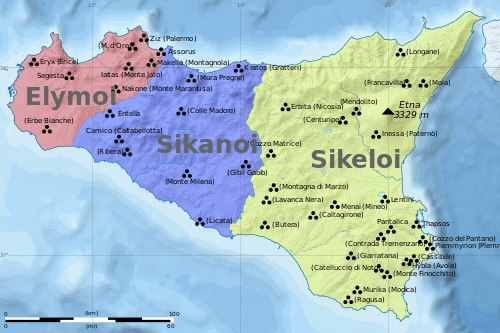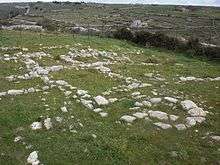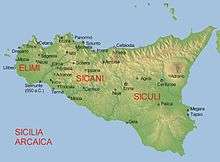Sicels
The Sicels (/ˈsɪkəlz, ˈsɪs-/; Latin: Siculi; Ancient Greek: Σικελοί Sikeloi) were an Italic tribe who inhabited eastern Sicily during the Iron Age. Their neighbours to the west were the Sicani. The Sicels gave Sicily the name it has held since antiquity, but they rapidly fused into the culture of Magna Graecia.

History

Archaeological excavation has shown some Mycenean influence on Bronze Age Sicily. The earliest literary mention of Sicels is in the Odyssey. Homer also mentions Sicania, but makes no distinctions: "they were (from) a faraway place and a faraway people and apparently they were one and the same" for Homer, Robin Lane Fox notes.[1]
It is possible that the Sicels and the Sicani of the Iron Age had consisted of an Illyrian population who (as with the Messapians) had imposed themselves on a native, Pre-Indo-European ("Mediterranean") population.[2] Thucydides[3] and other classical writers were aware of the traditions according to which the Sicels had once lived in Central Italy, east and even north of Rome.[4] Thence they were dislodged by Umbrian and Sabine tribes, and finally crossed into Sicily. Their social organization appears to have been tribal, their economy, agricultural. According to Diodorus Siculus,[5] after a series of conflicts with the Sicani, the river Salso was declared the boundary between their respective territories.
The common assumption is that the Sicels were more recent arrivals, had introduced the use of iron into Bronze Age Sicily and brought the domesticated horse. That would date their arrival on the island to the early 1st millennium BC. However, there is some evidence that the ethnonym may predate the Iron Age, based on the name Shekelesh given to one of the Sea Peoples in the Great Karnak Inscription in the late 13th century BC. Archaeological evidence points towards their arrival on the island between the thirteenth or eleventh century BCE.[6]
The Sicel necropolis of Pantalica, near Syracuse, is the best known, and the second-largest one is the Necropolis of Cassibile, near Noto. Their elite tombs a forno, or oven-shaped, take the form of beehives.
The chief Sicel towns were Agyrium (Agira); Centuripa or Centuripae (Centorbi but now once again called Centuripe); Henna (later Castrogiovanni, which is a corruption of Castrum Hennae through the Arabic Qasr-janni but, since the 1920s, once again called Enna); and three sites named Hybla: Hybla Major, called Geleatis or Gereatis, on the river Symaethus; Hybla Minor, on the east coast north of Syracuse (possibly pre-dating the Dorian colony of Hyblaean Megara); and Hybla Heraea in the south of Sicily.
With the coming of Greek colonists—both Chalcidians, who maintained good relations with the Sicels, and Dorians, who did not[7]—and the growing influence of Greek civilization, the Sicels were forced out of most of the advantageous port sites and withdrew by degrees into the hinterland. Sixty kilometres (forty miles) from the coast of the Ionian Sea, Sicels and Greeks exceptionally lived side by side in Morgantina to the extent that historians argue whether it was a Greek polis or a Sicel city. Greek goods, especially pottery, moved along natural routes, and eventually Hellenistic influences can be observed in regularised Sicel town planning. However, in the middle of the fifth century BC a Sicel leader, Ducetius, was able to create an organised Sicel state as a unitary domain in opposition to Greek Syracusa, including several cities in the central and south of the island. After a few years of independence, his army was defeated by the Greeks at Nomae in 450 BC, and he died ten years later. Without his charisma, the movement collapsed and the increasingly Hellenized culture of the Sicels lost its distinctive character. But in the winter of 426/5 Thucydides noted the presence among the allies of Athens in the siege of Syracuse of Sicels who had "previously been allies of Syracuse, but had been harshly governed by the Syracusans and had now revolted". (Thucydides 3.103.1) Aside from Thucydides, the Greek literary sources on Sicels and other pre-Hellenic peoples of Sicily are to be found in fragmentary scattered quotes from the lost material of Hellanicus of Lesbos and Antiochus of Syracuse.
There is some evidence that the Sicels had several matriarchal customs which is unattested in other Indo-European groups of the region.[8]
Language
| Sicel | |
|---|---|
| Sicula | |
| Region | Sicily |
| Era | attested 6th–3rd century BC[9] |
Indo-European
| |
| Greek | |
| Language codes | |
| ISO 639-3 | scx |
scx | |
| Glottolog | sicu1234[10] |
 Tribes of Hellenic Sicily | |
Linguistic studies have suggested that the Sicels may have spoken an Indo-European language[11] and occupied eastern Sicily as well as southernmost Italy[12] whereas the Sicani (Greek: Sikanoi) and Elymi (Greek Elymoi) inhabited central and western Sicily. It is likely that the two latter peoples spoke non-Indo-European languages, although this is far from certain, particularly with regard to the Elymian language, which some would consider related to Ligurian or to Anatolian, others to the other Italic languages.[13] The classification of the language of the Sicani remains uncertain.
Of the Sicel language the little that is known is derived from glosses of ancient writers and from a very few inscriptions, not all of which are demonstrably Sicel.[14] It is thought that the Sicels did not employ writing until they were influenced by the Greek colonists. Several Sicel inscriptions have been found to date: Mendolito (Adrano), Centuripe, Poira, Paternò‑Civita, Paliké (Rocchicella di Mineo), Montagna di Ramacca, Licodia Eubea, Ragusa Ibla, Sciri Sottano, Monte Casasia, Castiglione di Ragusa, Terravecchia di Grammichele, Morgantina, Montagna di Marzo (Piazza Armerina), and Terravecchia di Cuti.[15][16] The first inscription discovered, of ninety-nine Greek letters, was found on a spouted jug found in 1824 at Centuripe;[17] it uses a Greek alphabet of the 6th or 5th century BC. It reads:
- "nunustentimimarustainamiemitomestiduromnanepos duromiemtomestiveliomnedemponitantomeredesuino brtome…"
There have been various attempts at interpreting it (e.g. V. Pisani 1963, G. Radke 1996) with no sure results. Another long Sicel inscription was found in Montagna di Marzo:[18]
- "tamuraabesakedqoiaveseurumakesagepipokedlutimbe levopomanatesemaidarnakeibureitamomiaetiurela"
The best evidence for Sicel having been of Indo-European derivation is the verb form pibe "drink", a second-person singular present imperative active exactly cognate with Latin bibe (and Sanskrit piba, etc.).[19] Membership in the Italic branch, perhaps even close to Latino-Faliscan, cannot be ruled out: Varro states that Sicel was strictly allied to Latin as many words sounded almost identical and had the same meaning, such as oncia, lytra, moeton (Lat. mutuum).[20]
Religion
Their characteristic cult of the Palici is influenced by Greek myth in the version that has survived, in which the local nymph Talia bore to Adranus, the volcanic god whom the Greeks identified with Hephaestus, twin sons, who were "twice-born (palin "again"; ikein "to come"), born first of their nymph mother, and then of the earth, because of the "jealousy" of Hera, who urged Mother Earth, Gaia, to swallow up the nymph. Then the soil parted, giving birth to the twins, who were venerated in Sicily as patrons of navigation and of agriculture. In the most archaic level of Greek mythology, a titan, Tityos, grew so large that he split his mother's womb and had to be carried to term by Gaia herself. He came to the attention of later Greek mythographers only when he attempted to waylay Leto near Delphi. If such a mytheme is set into action as ritual, it is usual to see a pair of sacrificial children laid in the earth to encourage the green growth.
In the temple to Adranus, father of the Palici, the Sicels kept an eternal fire. A god Hybla (or goddess Hyblaea[21]), after whom three towns were named, had a sanctuary at Hybla Gereatis. The connection of Demeter and Kore with Henna (the rape of Proserpine) and of the nymph Arethusa with Syracuse is due to Greek influence.
Traces of the Sicels religion seems to have survived in the form of the sacred prostitution practiced in the sanctuary of Aphrodite at Mount Eryx.[22]
See also
- Ancient peoples of Italy
- Ancient Italic peoples
- Italiotes
- Prehistoric Italy
- Siceliotes
- Sea Peoples
- Sicani
Notes
- Fox, Travelling Heroes in the Epic Age of Homer, 2008:115; Homer's references are in Odyssey 20,383; 24.207-13, 366, 387-90.
- Fine, John (1985). The ancient Greeks: a critical history. Harvard University Press. p. 72. ISBN 0674033140.
Most scholars now believe that the Sicans and Sicels, as well as the inhabitants of southern Italy, were basically of Illyrian stock superimposed on an aboriginal "Mediterranean" population.
- The concern of Thucydides is to acquaint his Athenian audience with the cultural and historical background to Athenian invention in Sicilians affairs, beginning in 415 BC, in his book vi, sections 2.4-6.
- Servius' commentary on Aeneid VII.795; Dionysius of Halicarnassus i.9.22.
- Diodorus Siculus V.6.3-4.
- Le Glay, Marcel. (2009). A history of Rome. Wiley-Blackwell. ISBN 978-1-4051-8327-7. OCLC 760889060.
- Sjöqvist, Erik (1973). Sicily and the Greeks: Studies in the Interrelationship between the Indigenous Populations and the Greek Colonists. Jerome Lectures. Ann Arbor: University of Michigan Press. ISBN 0-472-08795-9.
- Le Glay, Marcel. (2009). A history of Rome. Wiley-Blackwell. ISBN 978-1-4051-8327-7. OCLC 760889060.
- Sicel at MultiTree on the Linguist List
- Hammarström, Harald; Forkel, Robert; Haspelmath, Martin, eds. (2017). "Sicula". Glottolog 3.0. Jena, Germany: Max Planck Institute for the Science of Human History.
- The basic study is Joshua Whatmough in R.S. Conway, J. Whatmough and S.E. Johnson, The Prae-Italic Dialects of Italy (London 1933) vol. 2:431-500; a more recent study is A. Zamponi, "Il Siculo" in A.L. Prosdocimi, ed., Popoli e civiltà dell'Italia antica, vol. 6 "Lingue e dialetti" (1978949-1012.)
- Thucydides reported that there were still Siculi in Italia, which only referred approximately to the modern Calabria in his time; he derived Italia from an eponymous Italos, a Sicel king (Histories, vi.4.6), cf. Name of Italy.
- http://lila.sns.it/mnamon/index.php?page=Lingua&id=59
- Price 1998.
- Luciano Agostiniani (2012). "Alfabetizzazione della Sicilia pregreca". Aristonothos 4. Retrieved January 22, 2018.
- Federica Cordano (2012). "Iscrizioni monumentali dei Siculi". Aristonothos 4. Retrieved January 22, 2018.
- Now in the Badisches Landesmuseum, Karlsruhe (Price 1998)
- Martzloff Vincent (2011). "Variation linguistique et exégèse paléo-italique. L'idiome sicule de Montagna di Marzo". La variation linguistique dans les langues de l’Italie préromaine (in French). Lyon. Archived from the original on 2015-04-02.
- Fortson, Benjamin W. IV (2009). Indo-European Language and Culture (Second ed.). Malden/Oxford: Wiley-Blackwell. p. 469. ISBN 978-1-4051-8895-1.
- Varro, De Lingua Latina V, 105 and 179.
- Lucia Chiavola Birnbaum (1 January 2000). Black Madonnas: Feminism, Religion, and Politics in Italy. iUniverse. pp. 31–. ISBN 978-0-595-00380-8.
- Le Glay, Marcel. (2009). A history of Rome. Wiley-Blackwell. ISBN 978-1-4051-8327-7. OCLC 760889060.
Sources
- Thucydides, vi.2 and vi.4.6
- Price, Glanville Encyclopedia of the Languages of Europe s.v. "Sicel (Siculan)"
Further reading
- Antonaccio, Carla M., and C. M. Antonacchio. "Κυπάρα, a Sikel Nymph?" Zeitschrift Für Papyrologie Und Epigraphik 126 (1999): 177-85. www.jstor.org/stable/20190439.
- Bernabò Brea, Luigi. 1966. Sicily before the Greeks. Revised edition. New York: F.A. Praeger.
- Boardman, John, editor. 1988. The Cambridge Ancient History. Volume 4, Persia, Greece and the Western Mediterranean, C.525 to 479 BC. 2nd edition. Cambridge: Cambridge University Press.
- Citter, Carlo, Giuseppe Maria Amato, Valentina Di Natale, and Andrea Patacchini. 2017. "A Stratified Route Network in a Stratified Landscape: The Region of Enna (Central Sicily) from the Bronze Age to the 19th c. AD." Open Archaeology 3 (1): 305–12.
- Ferrer, Meritxell. 2016. "Feeding the Community: Women's Participation in Communal Celebrations, Western Sicily (Eighth–Sixth Centuries BC)." Journal of Archaeological Method and Theory 23 (3): 900–20.
- Knapp, A. Bernard, and Peter van Dommelen, editors. 2014. The Cambridge Prehistory of the Bronze and Iron Age Mediterranean. Cambridge: Cambridge University Press.
- Leighton, Robert. 1999. Sicily before History: An Archaeological Survey From the Palaeolithic to the Iron Age. Ithaca, NY: Cornell University Press.
- ————. 2015. "Rock-cut Tombs and Funerary Landscapes of the Late Bronze and Iron Ages in Sicily: New Fieldwork at Pantalica." Journal of Field Archaeology 40 (2): 190–203.
- Martzloff, Vincent. Variation linguistique et exégèse paléo-italique. L’idiome sicule de Montagna di Marzo. In: La variation linguistique dans les langues de l’Italie préromaine. Lyon : Maison de l'Orient et de la Méditerranée Jean Pouilloux, 2009. pp. 93-132. (Collection de la Maison de l'Orient méditerranéen ancien. Série philologique) [www.persee.fr/doc/mom_0184-1785_2009_act_45_1_1985]
- Mentesana, Roberta, Giuseppe De Benedetto, and Girolamo Fiorentino. 2018. "One Pot's Tale: Reconstructing the Movement of People, Materials and Knowledge in Early Bronze Age Sicily through the Microhistory of a Vessel." Journal of Archaeological Science: Reports 19: 261–69.
- Oren, Eliezer D. 2000. The Sea Peoples and Their World: A Reassessment. Philadelphia: The University Museum, University of Pennsylvania.
- Russell, Anthony. 2017. "Sicily without Mycenae: A Cross-Cultural Consumption Analysis of Connectivity in the Bronze Age Central Mediterranean." Journal of Mediterranean Archaeology 30 (1): 59–83.
External links
| Library resources about Sicels |
- Archaic Italy: the Siculi (URL Checked 2006-03-26)
- Sicilian Peoples: The Sicels by Vincenzo Salerno